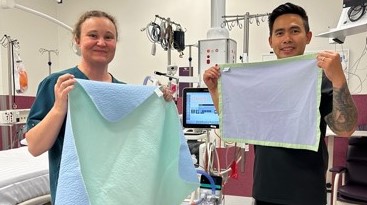Sunshine Hospital Intensive Care Unit (ICU) has introduced reusable pads — known as blueys and pinkies — saving 1,500kg waste from landfill in one year alone.
Each one of the new reusable blueys and pinkies (now known as fusion pads) are used to absorb liquids.
The single-use alternatives take more than 100 years to break down in the environment.
By introducing reusable pads into just one of our clinical areas almost 10,000 pinkies and more than 21,000 blueys were saved from landfill in 12 months alone.
It’s anticipated that as the pads are rolled out across the health service, the use of disposable products will continue to drop, delivering a range of sustainability benefits.
 SICU Equipment Nurse Kylie Feely led the trial with support from Edward Quilas.
SICU Equipment Nurse Kylie Feely led the trial with support from Edward Quilas.
Kylie and Edward job share the SICU Equipment Nurse role.
“Clinical staff use thousands of these absorbent pads every year,” Kylie said.
“They are used to trap and contain liquids, protect bedding, clothing and other surfaces, and provide an absorbent surface when clinical procedures are performed.”
“We also discovered some staff were unnecessarily layering blueys or pinkies in a bid to protect the linen underneath.”
Working with our linen supplier, Western Health helped to develop reusable blueys and fusion pads (pinkies) to replace the single-use disposable products.
Sustainable linen like the new reusable blueys and pinkies do not contain any plastic, each piece can be washed up to 200 times and they are expected to last around 2 years.
“Reusable linen is also recycled at end of life and turned into pulp, meaning they never see landfill,” Kylie said.
She said most carbon emissions occurred during linen production.
The company that produces the products estimate reuseable linen only produces 2 per cent of carbon emissions compared to disposal items.
Kylie said she was proud that the SICU now uses reuseable blueys and pinkies.
“I want to thank the SICU staff for being so supportive of the project and receptive to change, their help is crucial to the successful roll out of sustainability projects like these.”
The products underwent qualitative product evaluation, quantitative data analysis, and usage and cost reviews.
There has been a saving by making the switch to reuseable pads, even though the pinkies cost more initially.
“Figures suggest reusables are cost comparative,” Kylie said.
The ICU team has found that staff are using fewer pads overall.
Feedback from staff has been positive with some reports indicating that because they are made from linen instead of plastic, they are more breathable.
Kylie is also going to investigate whether the pads result in less pressure and shear injuries in patients because of the reduction in ‘double padding’ between the patient and the mattress.
Western Health Sustainability Lead Mariana Ibarra said innovative sustainability projects like these would have a positive impact on the healthcare system.
“Our Sustainability Plan embeds sustainability in all our operations to help us reach our target of net zero emissions by 2045,” Mariana said.
Western Health is committed to reducing the amount of waste going into landfill.
Associate Professor Forbes McGain, Director of Footscray ICU and Associate Dean of Sustainable Healthcare for Melbourne University said he had high hopes that reusable linen would become standard across the wider hospital community.
“The impact that reusable linen choices will have on the future of sustainable healthcare will be important, ongoing, and sets the standard for a new dawn.”
Western Health Intensive Care Units (ICUs) have been at the forefront of sustainability in healthcare efforts over many years with a range of innovative changes designed, tested and implemented, such as reuseable hospital gowns and recycling single-use medical items.
These efforts can save our health service money, reduce the consumption of resources and our environmental impact.
